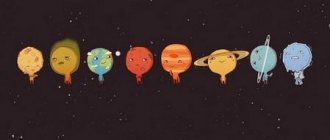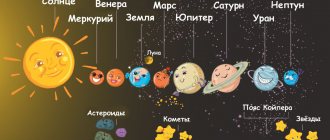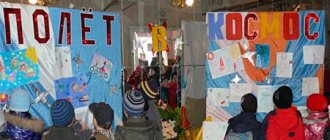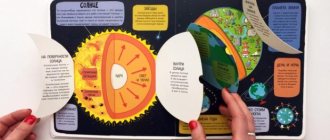When we raise our eyes to the sky, we see a lot of interesting things: during the day - the bright sun, airy clouds, a rainbow after rain or thunderclouds, and at night we watch the moon and admire the twinkling of many stars. The huge world above our heads is called the Universe or space. Space is so big that scientists still don't know much about it. For many years, people have been exploring outer space with the help of telescopes and spacecraft that explore the far corners of the Universe. Thanks to these inventions, we learned a lot of interesting things: what is the size of the sun, is it possible to live in space, and how long does it take to fly to other stars. However, the Universe is so huge and diverse that there are still many amazing discoveries ahead.
Development and education of children from 2 to 11 years old in a playful way
Start practicing right now
Start practicing
What is the Sun?
The sun that we see every day is a large and bright star. And what is it? A star is a huge hot ball of gas. There are a lot of different stars in space, but they are so far from us that they seem to us like small luminous points. The Sun is the closest star to us, so we see it very well. The bright and hot Sun gives light and warmth to all living things - from trees and flowers to animals and people.
Our home is planet Earth
If the Sun is a ball of gas, then maybe we also live on a star? Of course not. Under our feet there is a hard surface on which we can walk, run, rollerblade and ride a car. This cannot be done on the Sun, because it consists of gas. What then should we call the place where we live? Welcome to planet Earth! A planet is a space object that looks like a huge ball. There are several other planets near the Earth, and they are all very different: large and small, cold and hot, fast and slow. Let's get to know them!
How did the planets appear?
Astronomers believe that about 6 billion years ago, a galactic cloud of gas and dust, located on the territory of the Milky Way, presented in the form of a disk, began the process of compression towards its center, gradually forming the Sun.
According to one of the many theoretical positions, under the influence of gravity, a huge number of dust and gas elements that revolve around the Sun began to attract each other and formed balls, which later became planets.
According to another theory, a cloud consisting of gas and dust quickly began to disintegrate into separate clusters. They, gradually compressing and densifying, began to form planets.
Planets of the Solar System
In addition to the Earth, there are many other planets in space, but there are very few of them near us - only eight. These planets, together with the Earth, revolve around the star closest to us - the Sun. It attracts planets to itself as if they were its relatives. Scientists called such a cosmic family the Solar System. There are eight planets in the solar system. If you arrange them from closest to the Sun to the farthest, then the first will be Mercury, the second will be Venus, the third will be Earth, the fourth will be Mars, the fifth will be Jupiter, the sixth will be Saturn, the seventh will be Uranus, and the eighth planet will be Neptune. Planets are not just are close to the Sun, and all the time they revolve around it along their path, as if they were dancing in a circle. This path is called an orbit. Each planet has its own orbit, for example, the Earth makes a full revolution around the Sun in 365 days or, in another way, in one year. Did you know that each planet not only revolves around the Sun, but also rotates around its axis like a top? We call one revolution around its axis a day. On Earth, a day lasts 24 hours, but on other planets, a day passes either faster or much longer.
Ninth, tenth and wandering planets
Until 2006, astronomers officially believed that there was a 9th planet called Pluto, but due to recent research it has been classified as a dwarf planet. However, not all astronomers agree with this opinion. The surface of this celestial theme is considered the coldest in the solar system.
It is located very far from Earth, which means there is a lack of information about its exact dimensions and main chemical elements. In 2015, the New Horizons spacecraft was able to transmit some information. So it was determined that its diameter is more than 2300 km.
At the very edge of the solar system, not far from the Kuiper Belt, scientists have discovered a region of space where thousands of icy celestial bodies, small in size, are located. The main scientific theory, not officially accepted, suggests that this is where the 9th planet is located.
Researchers Brown and Batygin put forward a concept according to which it appeared within the Solar System, and then it was thrown virtually beyond its boundaries by the gravitational forces of the gas giants, Jupiter or Saturn, or both.
Astronomers concluded the existence of such a planet by analyzing the orbital deviations of 600 Kuiper Belt bodies. They suggested that they are influenced by the gravitational field of a large unknown celestial body the size of Mars, which has not yet been noticed by astronomers. This theory has not been proven.
In the 20th century, a theory appeared about a planet that could be located between Mars and Jupiter. At the moment, this concept is closer to the legend, which was first voiced by the American Immanuel Velikovsky.
He believed that the planet Tiamat, or Phaethon, was destroyed due to the passage of a large celestial body through the solar system. As a result, an asteroid belt appeared behind Mars. The American Zecharia Sitchin, studying Sumerian clay tablets, concluded that there may be a “wandering planet”, which they called Nibiru.
Nimble Mercury
Mercury is closest to the Sun - it is the smallest planet in the solar system. Mercury orbits the Sun the fastest, but it moves much slower on its axis. Because of this, it is always hot on one side, because the Sun is very hot. On the other side, on the contrary, it is very cold, because the sun's rays almost do not reach there. That's how amazing small and nimble Mercury is.
Dangerous Venus
In second place from the Sun is the planet Venus. It is very similar in size to our Earth, but people will not be able to live there. The air of Venus contains many poisonous gases that are impossible to breathe. And the surface of the planet gets very hot, so there is always intense heat there. Astronauts cannot go to explore Venus because the heat would immediately melt the rocket. This is the hottest planet in the solar system!
Our galaxy
Our galaxy is called the Milky Way. According to scientists, the Milky Way is a spiral system with a diameter of about 100 thousand light years and a thickness of 1 light year.
Also, according to their calculations, there are 150–200 billion stars in it and a huge number of other, very diverse space objects.
How to see the Milky Way
Theoretically, you can see the Milky Way at any time of the year in any part of the world, but the best months for viewing are from about mid-March to mid-October.
It is impossible to see the Milky Way from cities, and even villages, due to light pollution. Therefore, you need to drive as far as possible from populated areas.
Welcome to Earth!
We have already flown past Mercury and Venus, which means we will see Earth very soon. Our planet will be the third from the Sun. In size, the Earth is not the largest and not the smallest, but it is very different from others. With what? Our planet is the only place in the solar system where life exists. Thanks to its location from the Sun, water and clean air, living organisms began to appear on Earth many thousands of years ago. Only here you can see plants and animals, hear birds singing and visit many cities and countries where people live.
There is an interesting “neighbor” near our planet - the Moon. This is what we see in the sky every night. The Moon is a satellite of the Earth, which means that it revolves around our planet. The moon is so close to us that astronauts have even been there. Perhaps very soon scientists will begin to build special bases on the Moon where people can live.
Earth group
The planets of the solar system for children, and more specifically the terrestrial planets, are similar in their main components (iron and stone), as well as in their own size.
Mercury
The planets of the solar system (children will benefit from information about the entire structure of celestial bodies) include Mercury. This planet is the smallest. Its diameter is 4879 km. The planet is closest to the Sun. During the daytime, the temperature there rises to +350 °C, and at night it drops to -170 °C.
This planet's entire revolution around the star is 88 days, with a day equal to 59 Earth days. Scientists have studied periodic changes in the speed of rotation of this planet around the Sun.
Mercury has no atmosphere at all, which has caused regular falls of asteroids and meteorites, leaving multiple craters on its surface. Due to its close location to the Sun, the planet is very difficult to study.
The planet has the following chemical elements:
- hydrogen;
- argon;
- oxygen;
- helium;
- sodium.
Venus
The planets of the solar system (children will find it interesting to learn about their composition) include Venus. This celestial body is 2nd from the Sun after Mercury. Its dimensions are comparable to those on Earth, with a diameter of 12,104 km. A day on a planet is equal to 242 Earth days, and a year consists of 255 days.
Approximately 95% of the atmosphere of this planet is carbon dioxide, which has caused a permanent greenhouse effect. And the consequence of this phenomenon was a high temperature of about 475 °C.
Also, about 5% of the atmosphere is nitrogen. And only 0.1% is oxygen, which is the basis of respiration on Earth. There is practically no water or any other liquid on Venus; the planet is covered with basalt lava, which is in a frozen state.
There is a theory among astronomers according to which there once existed many seas and even oceans on the planet , but due to the enormous temperature they underwent the process of evaporation, and with the help of solar winds the steam flew into outer space.
Near Venus itself, astronomers have discovered weak winds. At an altitude of approximately 50 km, the winds become powerful and strong, their speed can reach 300 m/s.
On this celestial body there are also a huge number of elevations, as well as deep craters, reminiscent of the continents of the Earth. Astronomers explain this surface by the fact that Venus had a much less dense atmosphere many years ago.
Among the interesting facts about Venus, scientists also note that it moves from east to west, and this property is unique and not typical for other planets in the solar system. This uniqueness is primarily due to the fact that its atmosphere is capable of completely reflecting the light of the Sun. Also, this planet has no natural satellites.
Earth
Planet Earth is located 150 million km from the star. It is this distance that creates a unique temperature range that is suitable for large quantities of water. This created the prerequisites for the origin and development of life.
It will be useful for children to learn about the opinion of scientists who believe that in the solar system only on Earth there is life; it has not been found on other celestial bodies.
Approximately 2/3 of the planet's surface is covered by seas, oceans, and rivers. There is a theory that several million years ago the planet's atmosphere contained steam, which allowed a comfortable temperature to appear, as a result of which it turned into a liquid state.
Oxygen is an important component of the planet’s atmosphere, vital for photosynthesis and respiration of people, as well as various living organisms. In addition to this important chemical element, inert gases are present in the atmosphere, and more than 2/3 is nitrogen.
The diameter of the planet is 12,742 km. The planet has a natural satellite called the Moon. It is always turned towards the planet with only one side.
Mars
This is the 4th planet, counting from the central star. Mars is significantly smaller than its neighboring Earth. It has a radius of 6779 km. On Mars, the temperature range is recorded from -155 to +20 °C.
This planet has a small magnetic field and an atmosphere that is quite rarefied, as a result of which there is significant solar radiation on its surface, penetrating from outer space.
There has long been a question about the possible existence of life on this celestial body in the past, perhaps several thousand or even million years ago. Astronomers, based on theoretical assumptions and studies of the Red Planet, have come to the conclusion that this is only possible directly inside the planet, but not on its surface.
Probes and spacecraft were sent to the planet and discovered glacial accumulations there, as well as possible river beds.
On the surface of the planet, in particular in the sands, iron oxide was discovered, which gives it a red color, which is why it is called Red. Regular storms were observed on the surface, raising dust and having destructive potential.
The atmosphere of a celestial body mainly consists of carbon dioxide (more than 95%). There is also oxygen and water vapor, but their structural content is minimal. Mars has only 2 natural satellites: Deimos and Phobos. They are more similar to asteroids than to the Moon, they are small in size and uneven in shape.
Iron Mars
The fourth planet from the Sun is called Mars. It is unusual in that its entire surface is covered with iron. Because of this, the planet has a reddish-orange hue. Although Mars is smaller than Earth, a day on it lasts almost like ours - 24 hours 37 minutes. But the Martian year is much longer than the Earth's. In search of an answer to the question “Is there life on Mars?”, scientists have created special vehicles - rovers that walk on the surface of Mars and study the red planet. However, so far they have not been able to find signs of life on Mars.
Methods of representing space
Not every preschooler is able to understand what black holes are, what celestial bodies are made of, and what properties they have.
In order to explain, it is necessary to develop tactics. Firstly, the information must be truthful. Secondly, you cannot speak in serious language or use special terms. Otherwise, the child will quickly lose interest in the subject and will not want to continue a conversation he does not understand.
There are methods by which you can popularly teach children about the planets. Experience suggests that children are interested in conversation, supported by the display of pictures. You can use photographs of the starry sky, images of planets, constellations. It’s very good when dad draws the sun and talks about it. Moreover, the luminary should be depicted not as a yellow circle with rays emanating from it, but as a planet whose atmosphere contains hydrogen and helium.
A child must know the truth about the Universe. That people know little about the solar system and space. The sun is inaccessible due to high temperature, etc. In the same vein, we should talk about other planets and celestial bodies.
A model of celestial bodies can be depicted using plasticine. It's attractive and understandable. The main aspect is the child’s interest in the subject. His curiosity and desire to know more. In the case when the baby asks a question to which dad does not know the answer, it is necessary to postpone the consideration until tomorrow. And in the allotted time, prepare yourself for the correct answer.
Giant Jupiter
And we are flying further and further from the Sun and approaching the fifth planet, which is called Jupiter. It is the largest planet in the solar system. If you weigh all the planets together, Jupiter will be much heavier, that’s how huge it is! But an amazing fact: the giant does not have a solid surface to walk on, because Jupiter is a huge ball of gas. And on this planet strong winds constantly blow, which turn into storms, hurricanes and storms. These vortices are very clearly visible in photographs of the planet taken by space instruments. Do you know how many moons Jupiter has? Remember, the Earth has only one - the Moon, and Jupiter has almost 80 of them! Large and small, covered in ice, mountains and volcanoes, they all revolve around the gas giant. And Jupiter itself is not far behind - it spins around itself like a top, very quickly. Therefore, a day there lasts only 10 hours. This is what an amazing ruler of the sky there is among the planets of the solar system.
Gas giants
Jupiter
This planet is the largest in the solar system and has a diameter of 139,822 km, which is 19 times larger than Earth. A day on Jupiter lasts 10 hours, and a year is approximately 12 Earth years. Jupiter is mainly composed of xenon, argon and krypton. If it were 60 times larger, it could become a star due to a spontaneous thermonuclear reaction.
The average temperature on the planet is -150 degrees Celsius. The atmosphere consists of hydrogen and helium. There is no oxygen or water on its surface. There is an assumption that there is ice in the atmosphere of Jupiter.
Jupiter has a huge number of satellites - 67. The largest of them are Io, Ganymede, Callisto and Europa. Ganymede is one of the largest moons in the Solar System. Its diameter is 2634 km, which is approximately the size of Mercury. In addition, a thick layer of ice can be seen on its surface, under which there may be water. Callisto is considered the most ancient of the satellites, since it is its surface that has the largest number of craters.
Saturn
This planet is the second largest in the solar system. Its diameter is 116,464 km. It is most similar in composition to the Sun. A year on this planet lasts quite a long time, almost 30 Earth years, and a day lasts 10.5 hours. The average surface temperature is -180 degrees.
Its atmosphere consists mainly of hydrogen and a small amount of helium. Thunderstorms and auroras often occur in its upper layers.
Saturn is unique in that it has 65 moons and several rings. The rings are made up of small particles of ice and rock formations. Ice dust perfectly reflects light, so Saturn's rings are very clearly visible through a telescope. However, it is not the only planet with a diadem; it is just less noticeable on other planets.
Uranus
Uranus is the third largest planet in the solar system and the seventh from the Sun. It has a diameter of 50,724 km. It is also called the “ice planet”, as the temperature on its surface is -224 degrees. A day on Uranus lasts 17 hours, and a year lasts 84 Earth years. Moreover, summer lasts as long as winter - 42 years. This natural phenomenon is due to the fact that the axis of that planet is located at an angle of 90 degrees to the orbit and it turns out that Uranus seems to be “lying on its side.”
Uranus has 27 moons. The most famous of them are: Oberon, Titania, Ariel, Miranda, Umbriel.
Neptune
Neptune is the eighth planet from the Sun. It is similar in composition and size to its neighbor Uranus. The diameter of this planet is 49,244 km. A day on Neptune lasts 16 hours, and a year is equal to 164 Earth years. Neptune is an ice giant and for a long time it was believed that no weather phenomena occur on its icy surface. However, it was recently discovered that Neptune has raging vortices and wind speeds that are the highest among the planets in the solar system. It reaches 700 km/h.
Neptune has 14 moons, the most famous of which is Triton. It is known to have its own atmosphere.
Neptune also has rings. This planet has 6 of them.
Mysterious Saturn
Welcome to the sixth planet from the Sun called Saturn. Just like Jupiter, Saturn is made of gas, but it is much smaller in size than its neighbor. But Saturn has giant rings that make it easy to distinguish it from other planets. These rings are so huge that they can be seen even through a telescope. Scientists have been studying Saturn for many years, but until now they have not been able to understand how mysterious rings appeared around this planet. One thing is known: they all consist of particles of ice, dust, and stones.
Comparative table of the main parameters of planets and dwarf planets
All parameters below, except density, distance from the Sun and satellites, are indicated in relation to similar data from the Earth.
| Planet(dwarf planet) | Diameter, relative | Weight, relative | Orbital radius, a. e. | Orbital period, Earth years | Days, relative | Density, kg/m³ | Satellites |
| Mercury | 0,382 | 0,055 | 0,38 | 0,241 | 58,6 | 5427 | No |
| Venus | 0,949 | 0,815 | 0,72 | 0,615 | 243 | 5243 | No |
| Earth | 1,0 | 1,0 | 1,0 | 1,0 | 1,0 | 5515 | 1 |
| Mars | 0,53 | 0,107 | 1,52 | 1,88 | 1,03 | 3933 | 2 |
| Ceres | 0,074 | 0,00015 | 2,76 | 4,6 | 0,378 | 2161 | No |
| Jupiter | 11,2 | 318 | 5,20 | 11,86 | 0,414 | 1326 | 67 |
| Saturn | 9,41 | 95 | 9,54 | 29,46 | 0,426 | 687 | 62 |
| Uranus | 3,98 | 14,6 | 19,22 | 84,01 | 0,718 | 1270 | 27 |
| Neptune | 3,81 | 17,2 | 30,06 | 164,79 | 0,671 | 1638 | 14 |
| Pluto | 0,186 | 0,0022 | 39,2 | 248,09 | 6,387 | 1860 | 5 |
| Haumea | ~0,11 | 0,00066 | 43 | 281,1 | 0,163 | ~2600 | 2 |
| Makemake | 0,116 | ~0,0005 | 45,4 | 306,28 | 0,324 | ~1700 | No |
| Eris | 0,182 | 0,0028 | 67,8 | 558,04 | 1,1 | 2520 | 1 |
Approximate ratio of the sizes of the planets and the Sun. Interplanetary distances are not to scale. The sun is shown on the left.
Cold Uranus
Ahead is Uranus, the seventh planet of the solar system. Uranus is called the coldest planet, and there are also rings around it, but not as large as Saturn’s. Uranus is larger in size than Earth, but does not have a solid surface, so it can be called a gas planet. If you look at Uranus from space, it will be colored in an unusual blue-green color. This happens because there is a lot of methane gas on this planet, which gives the planet an incredibly beautiful hue.
Some features of transferring knowledge about space to children
Preschoolers are interested in space, but they cannot perceive and understand all the information correctly. At first, they are interested in:
- what the Sun is made of;
- what role does the luminary play in the life of the universe;
- for what reasons is our system called solar;
- how the planets are located;
- information on each planet, etc.
The most inquisitive kids are interested in questions:
- what is a constellation?
- what they are like;
- location of constellations in the sky, etc.










